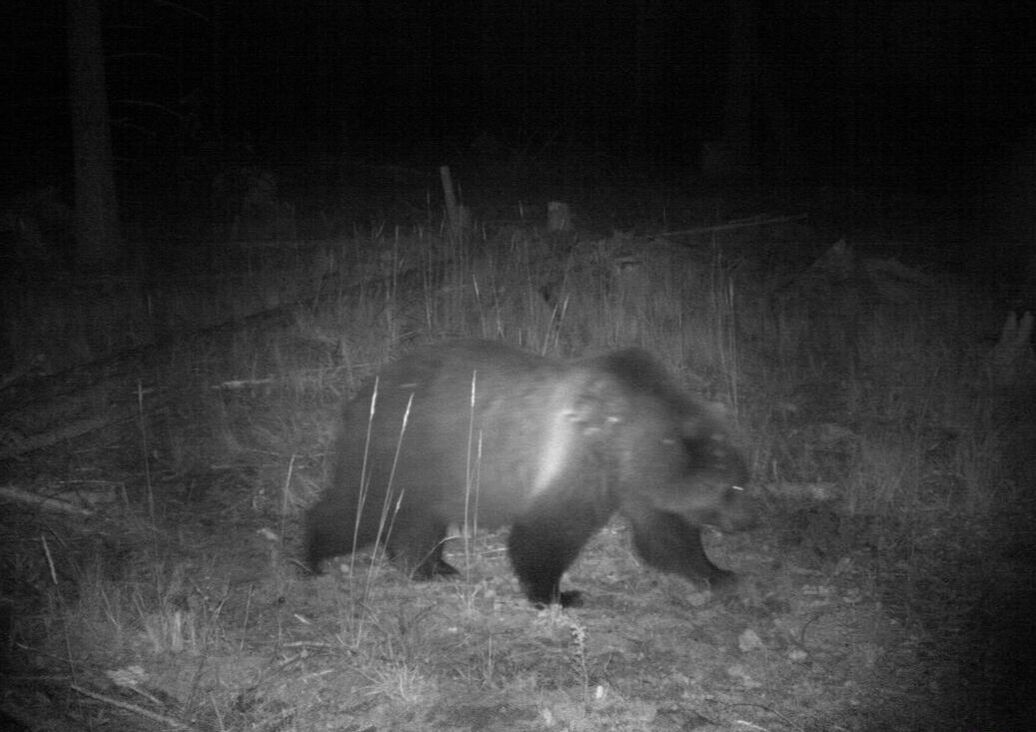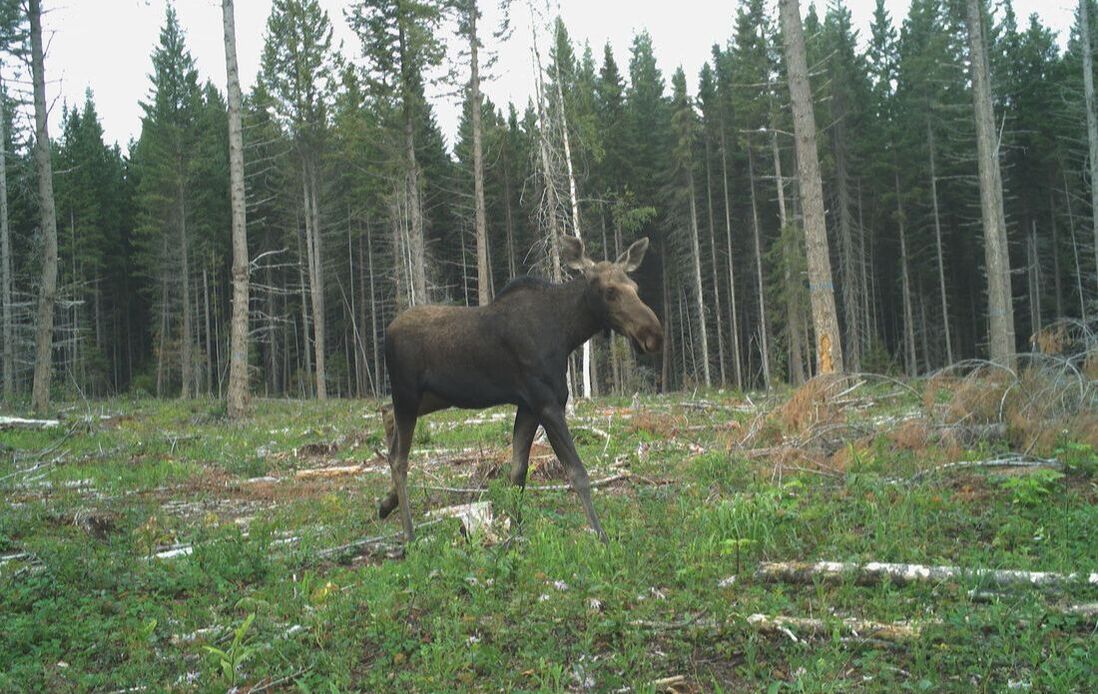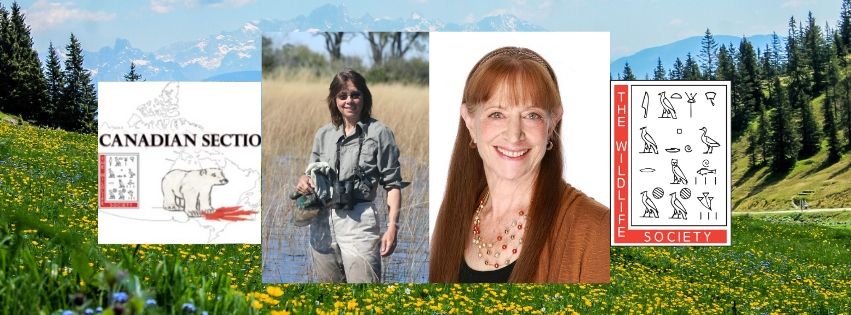2020 Webinar series
In light of the pandemic situation and cancellation of the 2020 Conference the BCTWS is at hard at work to create alternative opportunities for our members, students, and professionals from around BC to meet, interact, and share information about provincial research, current and changing issues, and emerging challenges.
On this note are incredibly excited to bring a number of the keynote speakers planned for the 2020 Conference to you via a live and interactive webinar series!
To register email [email protected] with subject line “register” and the title of the webinar. For example “register - Webinar 1: “TWS, the Big Picture” & "TWS, back home in Canada"
On this note are incredibly excited to bring a number of the keynote speakers planned for the 2020 Conference to you via a live and interactive webinar series!
To register email [email protected] with subject line “register” and the title of the webinar. For example “register - Webinar 1: “TWS, the Big Picture” & "TWS, back home in Canada"
uPCOMING WEBINARS
Watch this space for new webinars in 2021!
Past WEBINARS - 2020
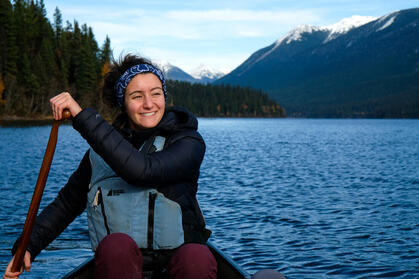
Webinar 8:
December 10, 2020
"Of Mice and Moose: Small and Large Mammal Responses to a Gradient of Forest Harvesting Treatments Across Interior BC" December 10 12:00 noon PST
Alexia Constantinou MSc Student, Wildlife Coexistence Lab & Belowground Ecology Group
Forest harvesting is part of the economic backbone of British Columbia, but the widespread use of clearcutting and the resulting homogenized landscape can be problematic for mammal species that depend on forest cover and structural diversity in uneven-aged stands. Partial harvest methods have been used to mitigate the effects of clearcuts on biodiversity while maintaining structural and functional diversity. Since winter 2018, we have been operating camera traps across a climate gradient in the interior of BC in forest harvesting treatments: clearcuts, seed tree retention, 30% and 60% partial harvests and uncut control forest. Concurrently, we live-trapped small mammals at the most northern site to determine the effects of the forest harvesting treatments on the entire terrestrial mammal community, and also incorporated a camera trap system specifically set up to analyze small mammals. By using non-invasive camera traps on small scale harvests, we are able to evaluate the frequency of usage of these harvesting techniques by all species, as well as their behaviour. Our results will improve understanding of wildlife responses to alternative forest harvest strategies across a climate gradient.
Alexia is a MSc student in the Wildlife Coexistence and Belowground Ecology Labs in the Faculty of Forestry at the University of British Columbia. She also serves as a Director of BCTWS and part-time Faculty at BCIT, teaching Wildlife Ecology and Management. Her work focuses on the relationship between forest harvesting and wildlife – she operates camera traps in the Kootenays, Cariboo and Nechako regions for medium- to large-sized mammals, and is also pairing camera traps with the live trapping of small mammals at her most northern site. Alexia is collaborating with First Nations in the Interior who are also interested in exploring camera traps and the effects of different partial retention forest harvesting methods on wildlife. Her interests include improving sustainable forest harvesting via holistic ecosystem management and consideration for wildlife, particularly with First Nations partnerships and perspectives.
December 10, 2020
"Of Mice and Moose: Small and Large Mammal Responses to a Gradient of Forest Harvesting Treatments Across Interior BC" December 10 12:00 noon PST
Alexia Constantinou MSc Student, Wildlife Coexistence Lab & Belowground Ecology Group
Forest harvesting is part of the economic backbone of British Columbia, but the widespread use of clearcutting and the resulting homogenized landscape can be problematic for mammal species that depend on forest cover and structural diversity in uneven-aged stands. Partial harvest methods have been used to mitigate the effects of clearcuts on biodiversity while maintaining structural and functional diversity. Since winter 2018, we have been operating camera traps across a climate gradient in the interior of BC in forest harvesting treatments: clearcuts, seed tree retention, 30% and 60% partial harvests and uncut control forest. Concurrently, we live-trapped small mammals at the most northern site to determine the effects of the forest harvesting treatments on the entire terrestrial mammal community, and also incorporated a camera trap system specifically set up to analyze small mammals. By using non-invasive camera traps on small scale harvests, we are able to evaluate the frequency of usage of these harvesting techniques by all species, as well as their behaviour. Our results will improve understanding of wildlife responses to alternative forest harvest strategies across a climate gradient.
Alexia is a MSc student in the Wildlife Coexistence and Belowground Ecology Labs in the Faculty of Forestry at the University of British Columbia. She also serves as a Director of BCTWS and part-time Faculty at BCIT, teaching Wildlife Ecology and Management. Her work focuses on the relationship between forest harvesting and wildlife – she operates camera traps in the Kootenays, Cariboo and Nechako regions for medium- to large-sized mammals, and is also pairing camera traps with the live trapping of small mammals at her most northern site. Alexia is collaborating with First Nations in the Interior who are also interested in exploring camera traps and the effects of different partial retention forest harvesting methods on wildlife. Her interests include improving sustainable forest harvesting via holistic ecosystem management and consideration for wildlife, particularly with First Nations partnerships and perspectives.
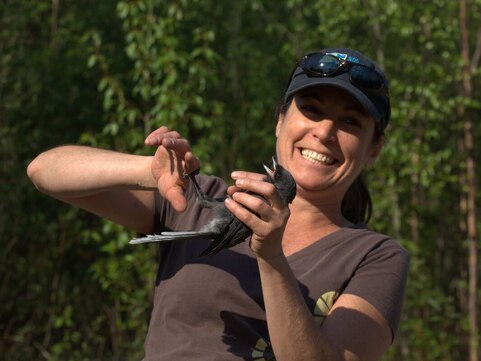
Webinar 7:
Nov 24, 2020
Webinar 7: “Avian Conservation in Yukon’s Northern Boreal Mountains"- Hilary Cooke November 24 12:00 noon PST
Hilary Cooke, PhD. Associate Conservation Scientist. Wildlife Conservation Society (WCS) Canada, Yukon.
Yukon provides breeding, nesting, and migratory habitat for approximately 300 bird species, including several species at risk and of conservation concern due primarily to threats outside Yukon. Population trends for North America’s boreal birds are alarming – an estimated one third overall population decline has occurred since 1970. Protecting northern boreal ecosystems is a critical component of full life-cycle conservation. In contrast to southern boreal regions, Yukon’s boreal mountains remain relatively free from the footprint of anthropogenic development and industrial activity. Opportunities for conservation include through regional land use planning, Indigenous Protected and Conserved Areas, project-based environmental assessments, and implementation of policies, management, and regulatory regimes. The range in scale of these mechanisms – from regional land use planning covering tens of thousands of square km to management practices impacting less than a hectare - demands a range of approaches to incorporate avian conservation values. Efforts are further complicated by a lack of published information on basic avian metrics, such as distribution, abundance, and habitat associations, as a result of low capacity and a mostly roadless and thus inaccessible landscape. Working with First Nation, territorial, and federal governments we employ a range of low and high tech approaches to fill information gaps and advance conservation. I’ll highlight how mapping bird habitat suitability for planning regions spanning 228,000 km2, counting 201,000 sandhill cranes in 10 days, and tracking a 24,000 km round trip migration of blackpoll warblers are all contributing to conservation of Yukon’s birds.
Bio – Dr. Hilary Cooke is Associate Conservation Scientist with Wildlife Conservation Society (WCS) Canada based in Whitehorse, Yukon. WCS Canada is a science-based conservation organization that aims to save wildlife and wild places in Canada through science, conservation action, and by inspiring people to value nature. Hilary has been engaged with avian research and conservation for two decades across western United States and western boreal Canada. She’s particularly fond of woodpeckers and the joy of spring migration in the North, and still wonders how she ended up living in a David Attenborough special.
Nov 24, 2020
Webinar 7: “Avian Conservation in Yukon’s Northern Boreal Mountains"- Hilary Cooke November 24 12:00 noon PST
Hilary Cooke, PhD. Associate Conservation Scientist. Wildlife Conservation Society (WCS) Canada, Yukon.
Yukon provides breeding, nesting, and migratory habitat for approximately 300 bird species, including several species at risk and of conservation concern due primarily to threats outside Yukon. Population trends for North America’s boreal birds are alarming – an estimated one third overall population decline has occurred since 1970. Protecting northern boreal ecosystems is a critical component of full life-cycle conservation. In contrast to southern boreal regions, Yukon’s boreal mountains remain relatively free from the footprint of anthropogenic development and industrial activity. Opportunities for conservation include through regional land use planning, Indigenous Protected and Conserved Areas, project-based environmental assessments, and implementation of policies, management, and regulatory regimes. The range in scale of these mechanisms – from regional land use planning covering tens of thousands of square km to management practices impacting less than a hectare - demands a range of approaches to incorporate avian conservation values. Efforts are further complicated by a lack of published information on basic avian metrics, such as distribution, abundance, and habitat associations, as a result of low capacity and a mostly roadless and thus inaccessible landscape. Working with First Nation, territorial, and federal governments we employ a range of low and high tech approaches to fill information gaps and advance conservation. I’ll highlight how mapping bird habitat suitability for planning regions spanning 228,000 km2, counting 201,000 sandhill cranes in 10 days, and tracking a 24,000 km round trip migration of blackpoll warblers are all contributing to conservation of Yukon’s birds.
Bio – Dr. Hilary Cooke is Associate Conservation Scientist with Wildlife Conservation Society (WCS) Canada based in Whitehorse, Yukon. WCS Canada is a science-based conservation organization that aims to save wildlife and wild places in Canada through science, conservation action, and by inspiring people to value nature. Hilary has been engaged with avian research and conservation for two decades across western United States and western boreal Canada. She’s particularly fond of woodpeckers and the joy of spring migration in the North, and still wonders how she ended up living in a David Attenborough special.
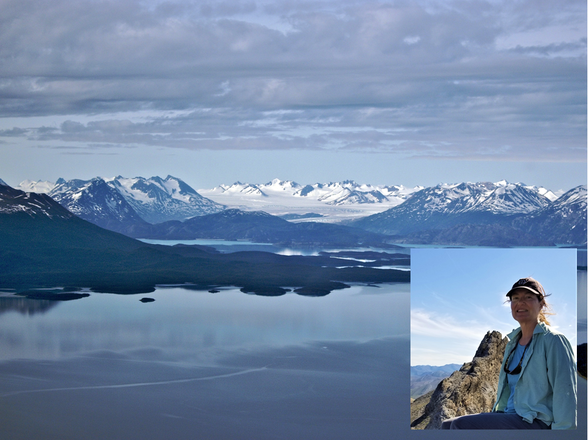
Webinar 6:
Nov 10, 2020
"Conservation Planning with Indigenous Communities: Weaving Two Ways of Knowing for a Shared Future" - Kimberly Heinemeyer, PhD
Indigenous-led land planning provide unprecedented opportunities to include indigenous knowledge (IK) to understand ecological and cultural values across landscapes. The deep, long temporal breadth of knowledge as well as the enduring stewardship commitment of indigenous people to their homelands provides a strong foundation for conservation planning of large landscapes. I provide examples of using IK to build species habitat models, IK-based ecosystem maps, and cultural landscape models. Through the incorporation of these IK-based spatial models within a Systematic Conservation Planning framework, we develop decision-support tools that support indigenous land visioning and planning. While the communities we work with are increasingly concerned about the potential impacts of a changing climate on their traditional values and territories, the complex suite of climate change metrics available are overwhelming, and we have found it challenging to explain or use many of these with our indigenous partners. We have linked predicted changes in major ecosystem distributions to the IK species habitat models to provide visual representations of the potential changes to key values. This work, carefully presented, resonates with communities, particularly when the selected species are of high cultural value. These predicted shifts in habitat distributions can also be incorporated into systematic conservation planning to allow planning for both current and potential future habitat distributions. Our work bridging Indigenous knowledge and values with western science and tools has provided rigorous spatial data platforms (maps) that support our indigenous partners to develop their own stewardship visions of large, connected landscapes which inherently support cultural and ecological resilience now and into an uncertain future.
Kimberly Heinemeyer, PhD
Project Director and Lead Scientist, Round River Canada
Director of Conservation Science, Round River Conservation Studies
Dr. Kimberly Heinemeyer is the Project Director and Lead Scientist at Round River Canada and Director of Conservation Science at Round River Conservation Studies. Round River Canada is a natural extension of the parent organization and reflects the growing involvement and commitment to our conservation partners in Canada. Kim has worked on large landscape conservation planning initiatives in Canada since 1998, including in partnership with the Taku River Tlingit, Carcross/Tagish, and Kwanlin Dun First Nations in northwestern BC and southern Yukon; the Inuvialuit and the Wildlife Management Advisory Council (YNS) for the Yukon North Slope; and with the Muskwa Kechika Advisory Board for NE BC. Through years of working with indigenous knowledge holders, Kim has acquired a deep respect and commitment to the value of Indigenous Knowledge (IK), and has spent much of her career learning from Knowledge Holders and developing respectful ways to weave IK with western science to inform and support indigenous land visioning and indigenous-led land relationship planning.
Nov 10, 2020
"Conservation Planning with Indigenous Communities: Weaving Two Ways of Knowing for a Shared Future" - Kimberly Heinemeyer, PhD
Indigenous-led land planning provide unprecedented opportunities to include indigenous knowledge (IK) to understand ecological and cultural values across landscapes. The deep, long temporal breadth of knowledge as well as the enduring stewardship commitment of indigenous people to their homelands provides a strong foundation for conservation planning of large landscapes. I provide examples of using IK to build species habitat models, IK-based ecosystem maps, and cultural landscape models. Through the incorporation of these IK-based spatial models within a Systematic Conservation Planning framework, we develop decision-support tools that support indigenous land visioning and planning. While the communities we work with are increasingly concerned about the potential impacts of a changing climate on their traditional values and territories, the complex suite of climate change metrics available are overwhelming, and we have found it challenging to explain or use many of these with our indigenous partners. We have linked predicted changes in major ecosystem distributions to the IK species habitat models to provide visual representations of the potential changes to key values. This work, carefully presented, resonates with communities, particularly when the selected species are of high cultural value. These predicted shifts in habitat distributions can also be incorporated into systematic conservation planning to allow planning for both current and potential future habitat distributions. Our work bridging Indigenous knowledge and values with western science and tools has provided rigorous spatial data platforms (maps) that support our indigenous partners to develop their own stewardship visions of large, connected landscapes which inherently support cultural and ecological resilience now and into an uncertain future.
Kimberly Heinemeyer, PhD
Project Director and Lead Scientist, Round River Canada
Director of Conservation Science, Round River Conservation Studies
Dr. Kimberly Heinemeyer is the Project Director and Lead Scientist at Round River Canada and Director of Conservation Science at Round River Conservation Studies. Round River Canada is a natural extension of the parent organization and reflects the growing involvement and commitment to our conservation partners in Canada. Kim has worked on large landscape conservation planning initiatives in Canada since 1998, including in partnership with the Taku River Tlingit, Carcross/Tagish, and Kwanlin Dun First Nations in northwestern BC and southern Yukon; the Inuvialuit and the Wildlife Management Advisory Council (YNS) for the Yukon North Slope; and with the Muskwa Kechika Advisory Board for NE BC. Through years of working with indigenous knowledge holders, Kim has acquired a deep respect and commitment to the value of Indigenous Knowledge (IK), and has spent much of her career learning from Knowledge Holders and developing respectful ways to weave IK with western science to inform and support indigenous land visioning and indigenous-led land relationship planning.
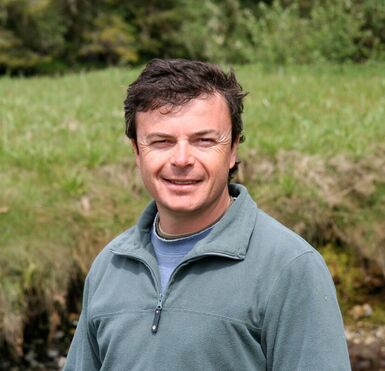
Webinar 5:
Oct 27, 2020
"Endangered Species and Community Science" - Tuesday Oct 27 12:00 noon PST
John Reynolds holds the Tom Buell BC Leadership Chair in Salmon Conservation and Management at Simon Fraser University. This research chair is funded through a partnership between the British Columbia Leading Edge Endowment, the Pacific Salmon Foundation, and numerous private and corporate donors. He is also the Chair of COSEWIC – the Committee on the Status of Endangered Wildlife in Canada. They are an independent panel of experts appointed by the federal Minister of Environment and Climate Change to assess the status wild species of plants and animals across Canada. The Minister then considers their status assessments in potentially listing species for protection under the Species at Risk Act.
Oct 27, 2020
"Endangered Species and Community Science" - Tuesday Oct 27 12:00 noon PST
John Reynolds holds the Tom Buell BC Leadership Chair in Salmon Conservation and Management at Simon Fraser University. This research chair is funded through a partnership between the British Columbia Leading Edge Endowment, the Pacific Salmon Foundation, and numerous private and corporate donors. He is also the Chair of COSEWIC – the Committee on the Status of Endangered Wildlife in Canada. They are an independent panel of experts appointed by the federal Minister of Environment and Climate Change to assess the status wild species of plants and animals across Canada. The Minister then considers their status assessments in potentially listing species for protection under the Species at Risk Act.
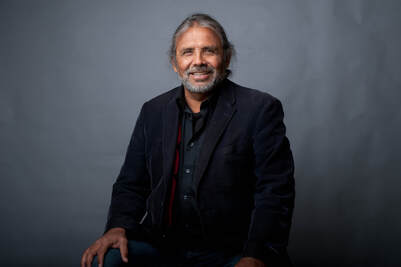
Webinar 4:
July 28, 2020
Webinar 4: Ken Edzerza Tuesday July 28 12:00 noon PST
To register email [email protected] with subject line “register” and the title of the webinar. For example “register - Webinar 4: “Ken Edzerza"
Next up in the #BCTWS summer webinar series is Ken Edzerza on July 28 at 12 noon. Ken has a Masters of Arts Degree in Leadership. A key finding of Ken's research was Cultural Governance. Ken is also the Vice-president of the Tahltan Central Government. During the past 30 years Ken has helped develop many aboriginal systems and is the past President of ISPARC (Indigenous Sports Physical Activity Recreation Council of BC). This organization won the Premiere's Award for organizational excellence last year. The topic Ken has chosen to explore is how wildlife professionals consult with Aboriginal people and governments. Mark your calendar and email us to register!
July 28, 2020
Webinar 4: Ken Edzerza Tuesday July 28 12:00 noon PST
To register email [email protected] with subject line “register” and the title of the webinar. For example “register - Webinar 4: “Ken Edzerza"
Next up in the #BCTWS summer webinar series is Ken Edzerza on July 28 at 12 noon. Ken has a Masters of Arts Degree in Leadership. A key finding of Ken's research was Cultural Governance. Ken is also the Vice-president of the Tahltan Central Government. During the past 30 years Ken has helped develop many aboriginal systems and is the past President of ISPARC (Indigenous Sports Physical Activity Recreation Council of BC). This organization won the Premiere's Award for organizational excellence last year. The topic Ken has chosen to explore is how wildlife professionals consult with Aboriginal people and governments. Mark your calendar and email us to register!
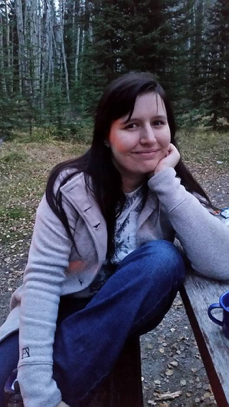
Webinar 3:
June 17, 2020
Webinar 3: “Together for Wildlife Strategy" Wed June 17, 2020 12:00 noon PST
To register email [email protected] with subject line “register” and the title of the webinar. For example “register - Webinar 2: “Together for Wildlife Strategy"
Kate Hewitt is currently the Natural Resources Manager at the Northern Shuswap Tribal Council (NSTC), representing the Northern Secwepemc te Qelmucw (NStQ), meaning ‘the Shuswap people of the north.’ Located in Williams Lake, Kate provides the NSTC and the NSTC Treaty Society with technical support and assistance on natural resources issues and works in collaboration with the four affiliated NStQ First Nations; Tsq’escen’, Stswecem’c/Xgat’tem, Xats’ull/Cmetem’, T’exelc (Canim Lake Indian Band, Canoe/Dog Creek Indian Band, Soda Creek Indian Band and the Williams Lake Indian Band), as part of the larger Shuswap Nation, to promote stronger participation in the management of natural resources within the Secwepemcul’ecw.
For this webinar Kate will be presenting on the provincial Together for Wildlife strategy as she maintains the role of Co-Chair on the First Nations – B.C. Wildlife and Habitat Conservation Forum, which came together within the context of the Provincial Government’s commitment to abide by UNDRIP, the TRC’s Calls to Action and the draft principles guiding its relationship with Indigenous Peoples.
Webinar 2:
June 10, 2020
Kootenay Connect: Ecological Corridors in the Kootenays
with Dr. Michael Proctor, Kootenay Connect, Trans-border Grizzly Bear Project
REGISTER HERE: https://us02web.zoom.us/webinar/register/WN_UAH1-7SuRziypMb2nPwuOw
June 10, 2020
Kootenay Connect: Ecological Corridors in the Kootenays
with Dr. Michael Proctor, Kootenay Connect, Trans-border Grizzly Bear Project
REGISTER HERE: https://us02web.zoom.us/webinar/register/WN_UAH1-7SuRziypMb2nPwuOw
Your browser does not support viewing this document. Click here to download the document.
*Webinar 1: “TWS, the Big Picture” & "TWS, back home in Canada"
May 12, 2020 12:00pm - 1:00pm
Dr. Winifred B. Kessler, PhD held faculty positions at the University of Idaho, Utah State University, and University of Northern British Columbia. She served 21 years with the U.S. Forest Service, retiring as a regional director for the Alaska Region. She is a Fellow and Past President of the Wildlife Society and the 2017 recipient of the Aldo Leopold Memorial Award. Wini serves as a director-at-large for the Canadian Wildlife Federation and chairs the board of the Habitat Conservation Trust Foundation. Her talk, “TWS, the Big Picture”, reviews the origins and history of The Wildlife Society, milestones in its evolution, and an overview of its role in advancing wildlife science, education, conservation, and the profession.
Dr. Evelyn Merrill (Evie) is a Professor in the Dept. of Biological Sciences at the Univ. of Alberta. Her interests are in ungulate foraging and habitat ecology with a current focus on trophic dynamics of a partially migratory elk population in the Rocky Mountains of Alberta, and spatial spread of CWD in the prairies provinces of Canada. She is a Fellow of The Wildlife Society and current the Canadian Section Representative to TWS. Her talk focuses on the CSTWS and is titled "TWS, back home in Canada"
May 12, 2020 12:00pm - 1:00pm
Dr. Winifred B. Kessler, PhD held faculty positions at the University of Idaho, Utah State University, and University of Northern British Columbia. She served 21 years with the U.S. Forest Service, retiring as a regional director for the Alaska Region. She is a Fellow and Past President of the Wildlife Society and the 2017 recipient of the Aldo Leopold Memorial Award. Wini serves as a director-at-large for the Canadian Wildlife Federation and chairs the board of the Habitat Conservation Trust Foundation. Her talk, “TWS, the Big Picture”, reviews the origins and history of The Wildlife Society, milestones in its evolution, and an overview of its role in advancing wildlife science, education, conservation, and the profession.
Dr. Evelyn Merrill (Evie) is a Professor in the Dept. of Biological Sciences at the Univ. of Alberta. Her interests are in ungulate foraging and habitat ecology with a current focus on trophic dynamics of a partially migratory elk population in the Rocky Mountains of Alberta, and spatial spread of CWD in the prairies provinces of Canada. She is a Fellow of The Wildlife Society and current the Canadian Section Representative to TWS. Her talk focuses on the CSTWS and is titled "TWS, back home in Canada"
